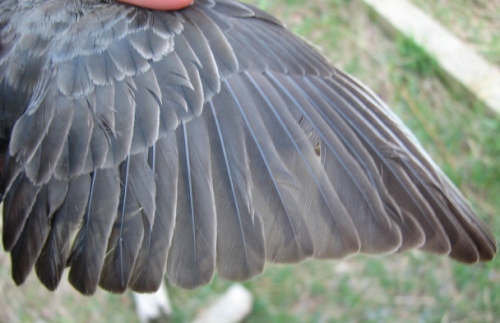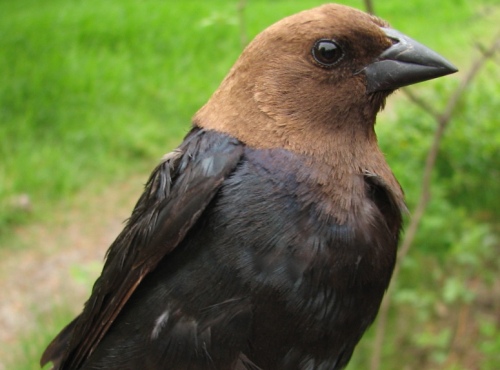Ageing and sexing details:
|
JAN - JUL: after-hatch-year
male |
Male Brown-headed Cowbirds are glossy black with brown heads; age can usually not be determined without examining the bird in the hand, and as some individuals may undergo a complete preformative moult, any in spring that have uniformly adult feathers should be considered after-hatch-year.

Photo by Marie-Anne Hudson,
McGill Bird Observatory (QC), May 2008
The upper wing is rarely informative for Brown-headed Cowbirds, as all ages typically replace all flight feathers and coverts during their preformative or prebasic moult. On the underwing, there may be contrast between feather tracts, but not within any of them.

Photo by Marie-Anne Hudson,
McGill Bird Observatory (QC), May 2008

Photo by Peter Pyle, Howell Woods (NC), May 2006
The rectrices on after-hatch-year cowbirds are uniformly adult.

Photo by Marie-Anne Hudson,
McGill Bird Observatory (QC), May 2008
RETURN TO AGE/SEX
OVERVIEW
|
JAN - JUL: after-hatch-year
female |
Female Brown-headed Cowbirds are a relatively pale grayish-brown; age can usually not be determined without examining the bird in the hand, and as some individuals may undergo a complete preformative moult, any in spring that have uniformly adult feathers should be considered after-hatch-year.

Photo by Marcel Gahbauer,
McGill Bird Observatory (QC), May 2005

Photo by Barbara Frei,
McGill Bird Observatory (QC), May 2007
The upper wing is rarely of any value in ageing cowbirds, as all individuals typically replace all feathers during their preformative or prebasic moult. Note in the photo of the underwing that there are subtle differences between feather tracts, but no moult limits within any of them.

Photo by Barbara Frei,
McGill Bird Observatory (QC), May 2007

Photo by Peter Pyle, Spokane (WA), May 2005
The rectrices on after-hatch-year cowbirds are uniformly adult.

Photo by Marie-Anne
Hudson, McGill Bird Observatory (QC), April 2006
RETURN TO AGE/SEX
OVERVIEW
|
JAN - JUL: second-year
male |
Male Brown-headed Cowbirds are glossy black with brown heads; age can usually not be determined without examining the bird in the hand, and as some individuals may undergo a complete preformative moult, only those in spring that retain any juvenile feathers should be considered second-year.

Photo by Marie-Anne Hudson,
McGill Bird Observatory (QC), May 2008

Photo by Barbara Frei,
McGill Bird Observatory (QC), May 2007
The upper wing is usually of no value in ageing Brown-headed Cowbirds. Rather, note the moult limits within tracts of the underwing coverts that indicate the retention of juvenile feathers and identify these as SY individuals.

Photo by Marie-Anne Hudson,
McGill Bird Observatory (QC), May 2008

Photo by Marcel Gahbauer,
McGill Bird Observatory (QC), May 2006

Photo by Peter Pyle, Spokane (WA), May 2005
Typically cowbirds replace all rectrices during their preformative or prebasic moult, but occasionally some HY birds retain one or more through their preformative moult, as in the example below where the contrast between the brownish juvenile rectrix and the replaced black adult rectrices on either side is easily visible.

Photo by Marie-Anne Hudson,
McGill Bird Observatory (QC), May 2008
RETURN TO AGE/SEX
OVERVIEW
|
JAN - JUL: second-year
female |
Moult limits among the underwing coverts are much more difficult to spot on females, as differences in shades of brown are subtle; in this case, the very loos quality of the juvenile coverts is an indication that this is a second-year female.

Photo by Peter Pyle, MerryLea (IN), May 2005
RETURN TO AGE/SEX
OVERVIEW
|
JUL - DEC: after-hatch-year
male |
RETURN TO AGE/SEX
OVERVIEW
RETURN TO AGE/SEX
OVERVIEW
|
JUL - DEC: hatch-year
female |
RETURN TO AGE/SEX
OVERVIEW